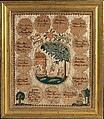Sampler
Embroidered by Julia Ann Fitch American
Not on view
This exquisite Federal pictorial family record has much to say about the importance of educating women and the ideals of the young country. The beautifully worked center reserve depicts a young woman reading a book sitting under a unique architectural structure—an outdoor pavilion with a round doomed roof, draped and curtained sides, and a checkerboard floor.
This curtained canopy is often seen as the seat of royalty in seventeenth century English needlework. (See MMA 64.101.1307; 64.101.1304; 64.101.1315). Julia Ann likely placed a young woman reading a book under such a structure to connote the esteemed position she attached to women’s literacy and education. In a landscape completely peopled by females, in front of the young woman in the pavilion, an elegantly dressed lady with a parasol strolls toward another women sitting beneath a tree who may be instructing the young girl who stands in front of her.
Julia Ann grew up in Hatfield, Massachusetts, where Joseph Lyman (1749-1828), pastor of Hatfield’s Congregational Church, was an ardent champion of education for both sexes. Local interest in educating young women resulted in the opening of two schools for girls in 1796. Girls often attended several different schools. Julia Ann may have attended a dame school in Hatfield and the Young Ladies Academy run by Mr. and Mrs. Tuchett in nearby Northampton, Massachusetts, that advertised in 1807 that they taught "the elegant accomplishments of Drawing, Painting, and Emboidery" and charged 8 dollars for "Drawing - Embroidery, and Fancy Needlework."
Julia Ann’s use of the thirteen circles, or links in a chain, surrounding the central scene display not only the names and dates of her own immediate family, but also refers to her position as a member of the first generation of young girls to be born in the New Republic. Her patriotism is seen in a circle on the lower left commemorating the birth and death dates of the "Father of Our Country" President George Washington. On the lower right there is a circle stating the birth of the country in 1776. Julia’s own name circle is nestled in between these two links. The thirteen circles refer to well-known image of the original thirteen American colonies forming an unbreakable chain. This interlocking configuration is found on Amos Dolittle’s 1794 print entitled, A Display of the United States of America, as well as on the American "Fugio" penny coin of 1787.
Julia Ann was the daughter of John F[ield] Fitch (1766-1819) and Lucy Mather Fitch (1770-1862), and her two brothers and three sisters were all born between 1788 and 1798. Julia Ann’s mother was a descendant of the Rev. Increase Mather (1639-1723), the sixth president of Harvard College. Her father’s descendants were from another early New England family. Julia Ann married Thaddeus Hosmer (1792-1849) and there is no record of their having children, perhaps because of her early death on March 26, 1818, at the age of twenty-six. Julia Ann’s sampler survives as tribute to the importance she attributed to female education, the pride she took in her new nation, and the familial way she viewed being an American in the early years of the nineteenth century.
Due to rights restrictions, this image cannot be enlarged, viewed at full screen, or downloaded.














